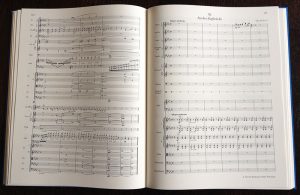Jean Sibelius Complete Works (JSW)
edited by the National Library of Finland and the Sibelius Society of Finland
Series I (Orchestral Works), Vol. 15:
Scènes historiques I, Op. 25, and II, Op. 66, edited by Kari Kilpeläinen
Set I: All’Overtura – Scena – Festivo (1899, rev. 1911)
Set II: Die Jagd – Minnelied – An der Zugbrücke (1912)
SON 625 · Price €192.60
228 pages · 25 x 32 cm · 1186 g · ISMN: 979-0-004-80327-1 · Linen
https://www.breitkopf.com/work/6198/16453
Breitkopf & Härtel’s excellent JSW (Jean Sibelius Werke) series of critical editions, which will ultimately include the composer’s entire output in modern and painstakingly researched editions, continues with the two sets of Scènes historiques, Op. 25 and Op. 66. On this occasion the music has been expertly edited by Kari Kilpeläinen, who continued the preliminary work on Op. 66 undertaken by Nors S. Josephson.
Like the much more famous Finlandia, the Op. 25 set of Scènes historiques traces its origins back to Sibelius’s second major score for historical tableaux, the Press Celebrations Music, JS 137, of 1899, and indeed Sibelius described its three movements as ‘some pieces that are as good as Finlandia’. The selection and history of these three pieces is relatively straightforward and well documented, and is thoroughly described in the introduction to this volume, in English and German, with reference to Sibelius’s diaries and correspondence as well as contemporary reviews. In the case of the Op. 66 set, however, the story is more complicated, and the JSW reveals its story in greater detail than has been generally known before. The three pieces have little to do with the Press Celebrations Music, although Kilpeläinen identifies the occasional motif from the 1899 score alongside ideas sketched in numerous other contexts.
Despite the enthusiasm of several notable Sibelius scholars – Robert Layton uses terms such as ‘undeniably first class’ and ‘masterly’ – these two suites, lasting some eighteen minutes apiece, have remained relative rarities in concert. They have, at least, appeared numerous times on disc, in recent decades mostly as complete suites (e.g. Jalas, Gibson, Järvi, Saraste, Inkinen) although earlier conductors tended to make selections (e.g. Beecham, Barbirolli). The first of the Scènes historiques to become well-known on disc was Festivo from Op. 25, in performances conducted by Sir Thomas Beecham and Hans Rosbaud.
The principal source material for the Scènes historiques was the previous printed edition, also published by Breitkopf & Härtel, specifically the score. To quote the commentary: ‘Because of many obvious errors and inaccuracies appearing in the parts…, the score… is more reliable; therefore, [the score] has served as the main source, although the reading in [the parts] has been taken into account in many passages as well.’
In the case of the first and third movements of the second suite, however – Die Jagd and An der Zugbrücke – there were also autograph manuscript scores (and, for Die Jagd, some orchestral parts), on the basis of which the original versions of these movements – as performed by Sibelius on on 29 March 1912 – have been included in the volume as well. The revisions were undertaken immediately after the first performance. The most obvious difference is that the original version of An der Zugbrücke omits the harp: in the final version it has a prominent role in the second half of the piece. Otherwise, the differences consist mostly of small adjustments to instrumentation, pitches, dynamics and articulation – more in An der Zugbrücke than in Die Jagd. One example of this is the unexpected fz violin chord a couple of bars after A in An der Zugbrücke: in the original score this effect is entirely missing, as there is no fz at all. Kari Kilpeläinen observes that the original version of this movement was written in great haste in the days before the first performance, so presumably Sibelius had no time to work on the finer details. In fact there were also revisions to the second movement, Minnelied, apparently more extensive than in the outer movements, but no material for the original version of that movement has survived.
As usual in the JSW series, there are facsimiles of selected manuscript pages as well as detailed critical remarks at the end of the volume, which shed light on assorted interpretative details. For instance, the extraneous cymbal notes occasionally heard in Festivo (Op. 25 No. 3: bars 33–34 and 184–185) are revealed to be a straightforward misprint: the notes were written in the cymbal part rather than the triangle part that Sibelius intended.
It goes without saying that for any conductor or orchestra preparing to perform this music, the new volume is indispensable. For non-performers, too, the introduction and critical comments are a treasure trove of fascinating new information, and the inclusion of the two early versions provides a generous helping of icing on the cake.
Review by Ian Maxwell & Andrew Barnett
Review copy kindly supplied by Breitkopf & Härtel
